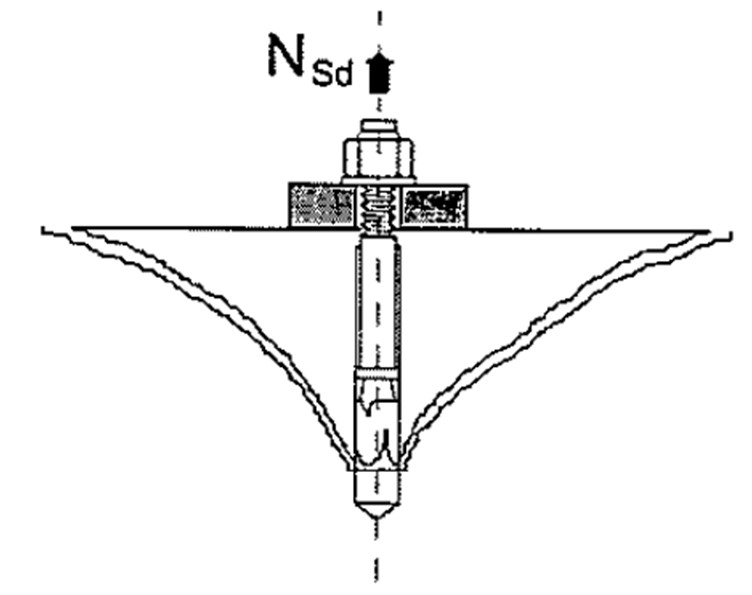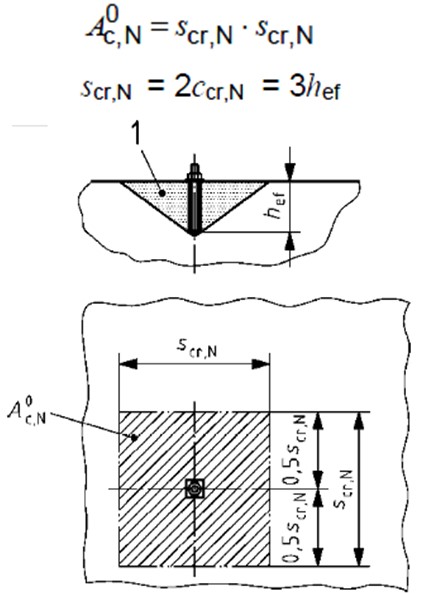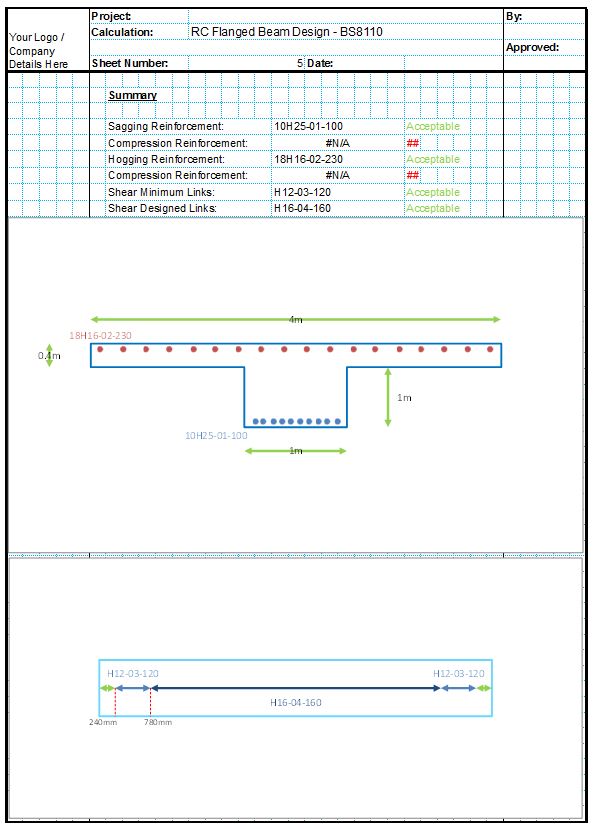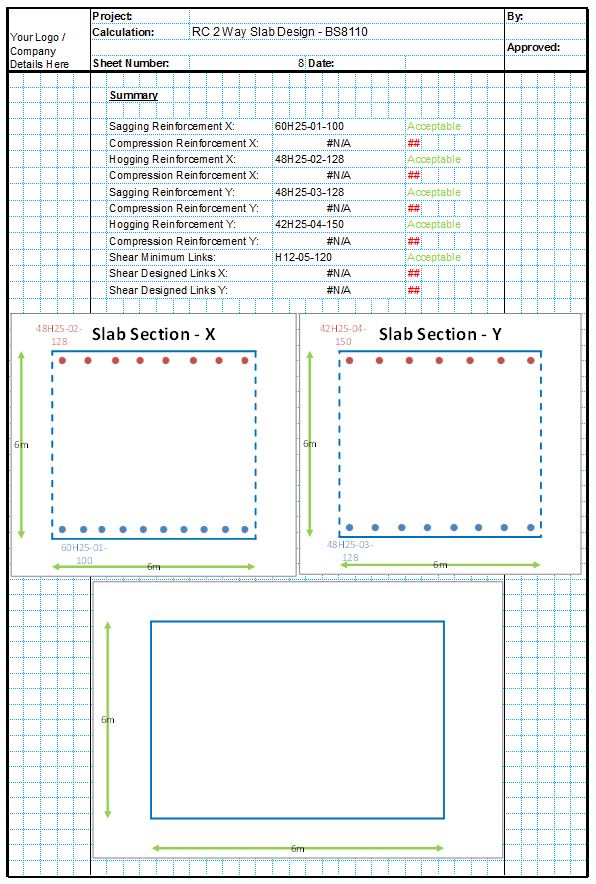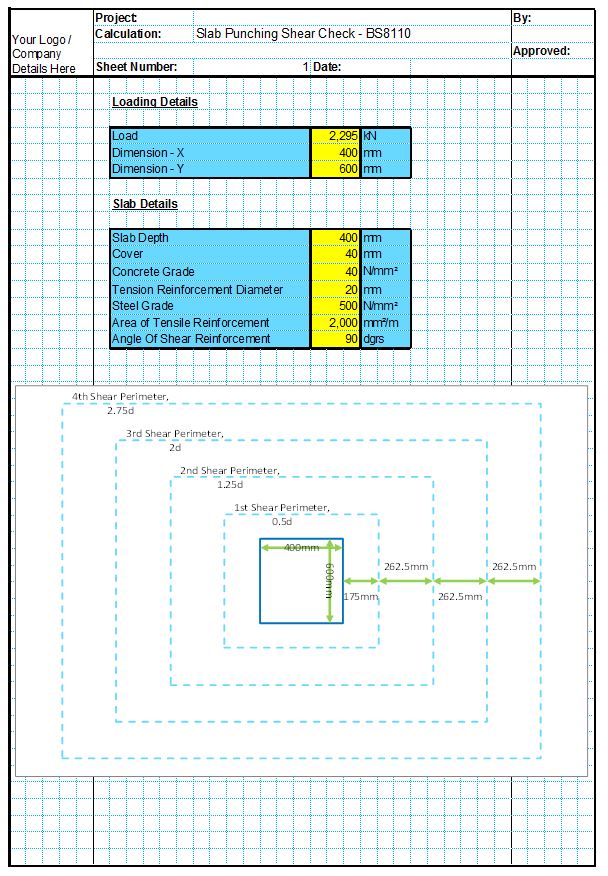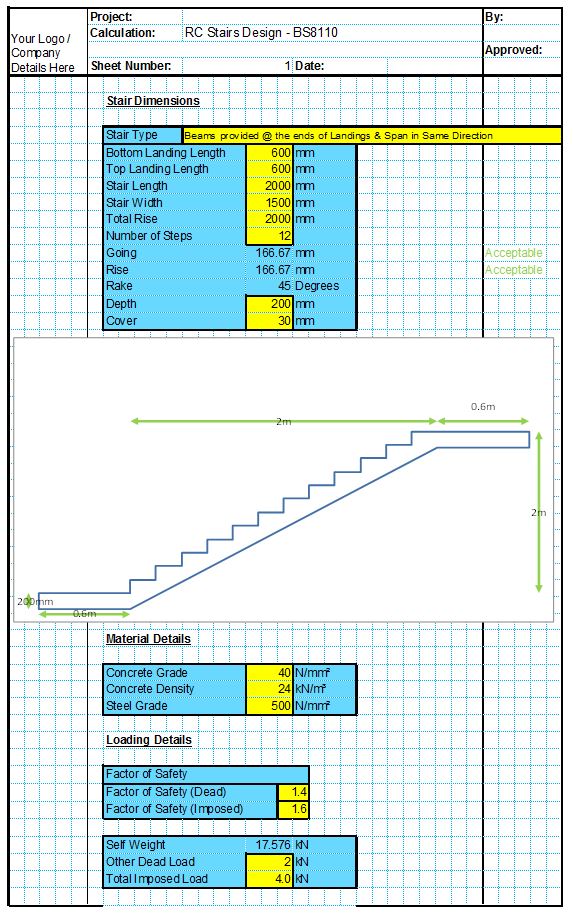Concrete Cone Failure occurs when the concrete surrounding an anchor fails, typically in a cone shape similar to the diagram below. This failure mode is applicable for Cast In, Mechanical Fasteners and Chemical Anchors. The CivilWeb Concrete Anchorage Design Spreadsheet completes all the calculations detailed below for cast in anchors, mechanical anchors and chemically bonded anchors in accordance with BS EN 1992-4.
For cast in anchors supplementary reinforcement can be installed to resist the tensile forces instead of relying on the concrete cone strength. This is typically used when very large tensile forces are present or where the fastener must be installed close to the concrete edge or corner. In these cases the concrete cone strength calculations can be ignored and the calculations completed for the supplementary reinforcement.
Concrete Cone Failure Design Verification Calculations
To avoid concrete cone failure the resistance of the single fastener or group concrete cone must be greater than the tensile force, as shown in the below equation;
Partial Safety Factor for Concrete Cone Failure (γMc)
This partial safety factor is calculated using the below formula which depends on the quality of the installation.
Partial Safety Factor for Concrete (γc)
A value of 1.5 is typically recommended.
Characteristic Resistance to Concrete Cone Failure (NRk,c)
The characteristic resistance to concrete cone failure is given by the following equation;
Initial Characteristic Resistance to Concrete Cone Failure – Single Fastener (N0Rk,c)
This is dependent on whether the concrete is cracked or uncracked.
Load Transfer Factor (kcr)
This factor accounts for the load transfer mechanisms present in cracked and uncracked concrete. This value is given by the manufacturer. A value of 7.2 is often used for cracked concrete, and 10.1 is often used for uncracked concrete. The CivilWeb Concrete Anchorage Design Spreadsheet uses these values but this can be manually input to suit any type of fastener.
Characteristic Cube Strength of Concrete (fck,cube)
This can be taken from tests taken during the concrete pour or from design info.
Effective Depth (hef)
This is the effective embedment depth of the anchor. Where a narrow concrete member is being considered there may be 3 or 4 sides which are constrained by the proximity of the edges. In these cases the Effective Depth (hef) should be modified using the following equations;
For single fasteners;
Or for groups, the larger value of the two below equations;
Max Distance from Fastener Centre to Concrete Edge (Cmax)
Max Centre to Centre Spacing of Fasteners (Smax)
An example diagram is shown below.
Geometric Effects Factor (Ac,N & A0c,N)
The overall pullout capacity of a fastener or group of fasteners can be affected by the proximity of the concrete edges and by the capacity of other fasteners connected into a group.
Reference Projected Area (A0c,N)
This is the idealized projected area for a single fastener unconfined by concrete edges. This can be calculated with the following equations;
Alternative values for scr,N can sometimes be specified by the manufacturer.
Actual Projected Area (Ac,N)
This is the idealized actual projected area for the fastener or group including confinement by concrete edges and overlapping areas of adjacent fasteners in the same group. A few examples of this calculation are shown below;
The calculation of these areas in practice can be laborious, particularly where the location is not fixed and needs to be optimized. The CivilWeb Concrete Anchorage Design Spreadsheet allows the user to input the basic geometrical parameters of the concrete member and the fastener or group and then calculates the maximum concrete cone resistance instantly. This can then be easily optimized by adjusting the position of the fastener or group.
Concrete Edge Effects Factor (Ψs,N)
When a fastener or group is placed close to the edge of the concrete unit this alters the distribution of stresses in the concrete. This effect can have a significant reduction in concrete cone pull out capacity when fasteners are installed close to the concrete edge. This effect can be calculated using the below equation;
Smallest Distance to Concrete Edge (c)
Ccr,N (As defined above)
Shell Spalling Effects Factor (Ψre,N)
For anchors installed with an Effective Depth of less than 100mm, there may be a reduction in concrete cone pull out capacity as the strength of the reinforcement will not be fully mobilized. This is ignored if the reinforcement is densely spaced (<150mm spacing). This effect can be calculated using the below equation;
Effective Depth (hef)
This is the effective depth of the anchor.
Eccentricity Effects Factor (Ψec,N)
This factor takes account of the effects of eccentrically loaded anchor groups. This can be calculated using the below equation;
Eccentricity of the Resulting Tensile Load (eN)
Scr,N (As defined above)
Where the resulting tensile load is eccentric in two directions, the factor should be calculated in each direction and multiplied together.
Concrete Cone Failure - CivilWeb Concrete Anchorage Design Spreadsheet
The CivilWeb Concrete Anchorage Design Spreadsheet completes all the above calculations in order to complete the design check against concrete cone failure. Concrete cone failure is often the critical condition, particularly for small anchors placed away from the edges of the concrete member. For this reason it is often concrete cone failure which determines the required depth of the anchor. The CivilWeb Concrete Anchorage Design Spreadsheet includes unique design tools including our design graphs which show the designer at a glance exactly how deep the anchor needs to be too prevent concrete cone failure.
Get your copy of the CivilWeb Concrete Anchorage Design Spreadsheet now for only £20.
Download Free Trial Version
To try out a fully functional free trail version of this software, please Click Here or enter your email address below to sign up to our newsletter.
